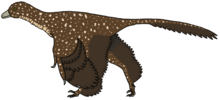Extinct genus of dinosaurs
Pedopenna (meaning "foot feather") is a
Daohugou Beds where it was found is debated. A majority of studies suggest that beds probably date from between the late
Middle Jurassic (168 million years ago) and early
Late Jurassic Period (164-152 million years ago).
[1]The name Pedopenna refers to the long
pennaceous feathers on the metatarsus;
daohugouensis refers to the locality of Daohugou, where the
holotype was found.
[2] Pedopenna daohugouensis probably measured 1 meter (3 ft) or less in length, but since this species is only known from the hind legs, the actual length is difficult to estimate.
Pedopenna was originally classified as a
paravian, the group of
maniraptoran dinosaurs that includes both
deinonychosaurs and
avialans (the lineage including modern birds), but some scientists have classified it as a true avialan more closely related to modern birds than to deinonychosaurs.
[3] More recently, it has been recovered as a
scansoriopterygid.
[4] Lately it was placed to the family Anchiornithidae.
[5]Description
The feet of Pedopenna resembled those of the related
dromaeosaurids (which together form the group
Deinonychosauria), though were overall more primitive. In particular, the second toe of
Pedopenna was not as specialized as in deinonychosaurs. While
Pedopenna did have an enlarged claw and slightly shortened second toe, it was not as highly developed as the strongly curved, sickle-like claws of its relatives.
[2]Daohugou fossil beds where
Pedopenna was found as mid to late
Jurassic in age, used the presence of such a primitive member of the avian lineage, in combination with many primitive members of closely related lineages there, to support the idea that birds originated in
Asia.
[2]Feathers
The bird-like characteristics of Pedopenna are further evidence of the dinosaur-bird evolutionary relationship. Apart from having a very bird-like skeletal structure in its legs, Pedopenna was remarkable due to the presence of long
coverts as seen in modern birds. Since the feathers show fewer aerodynamic adaptations than the similar hind wings of
Microraptor, and appear to be less stiff, suggests that if they did have some kind of aerodynamic function, it was much weaker than in deinonychosaurs and birds.
[citation needed]
Xu and Zhang, in their 2005 description of Pedopenna, suggested that the feathers could be ornamental, or even vestigial. It is possible that a hind wing was present in the ancestors of deinonychosaurs and birds, and later lost in the bird lineage, with Pedopenna representing an intermediate stage where the hind wings are being reduced from a functional gliding apparatus to a display or insulatory function.[2] this theory may be confirmed by the discovery of Serikornis in 2017, an anchiornithid with soft, symmetrical feathers and filaments on parts of the body that were similar to Pedopenna's.
References
- .
- ^ .
- .
- .
- , retrieved 2023-07-12

